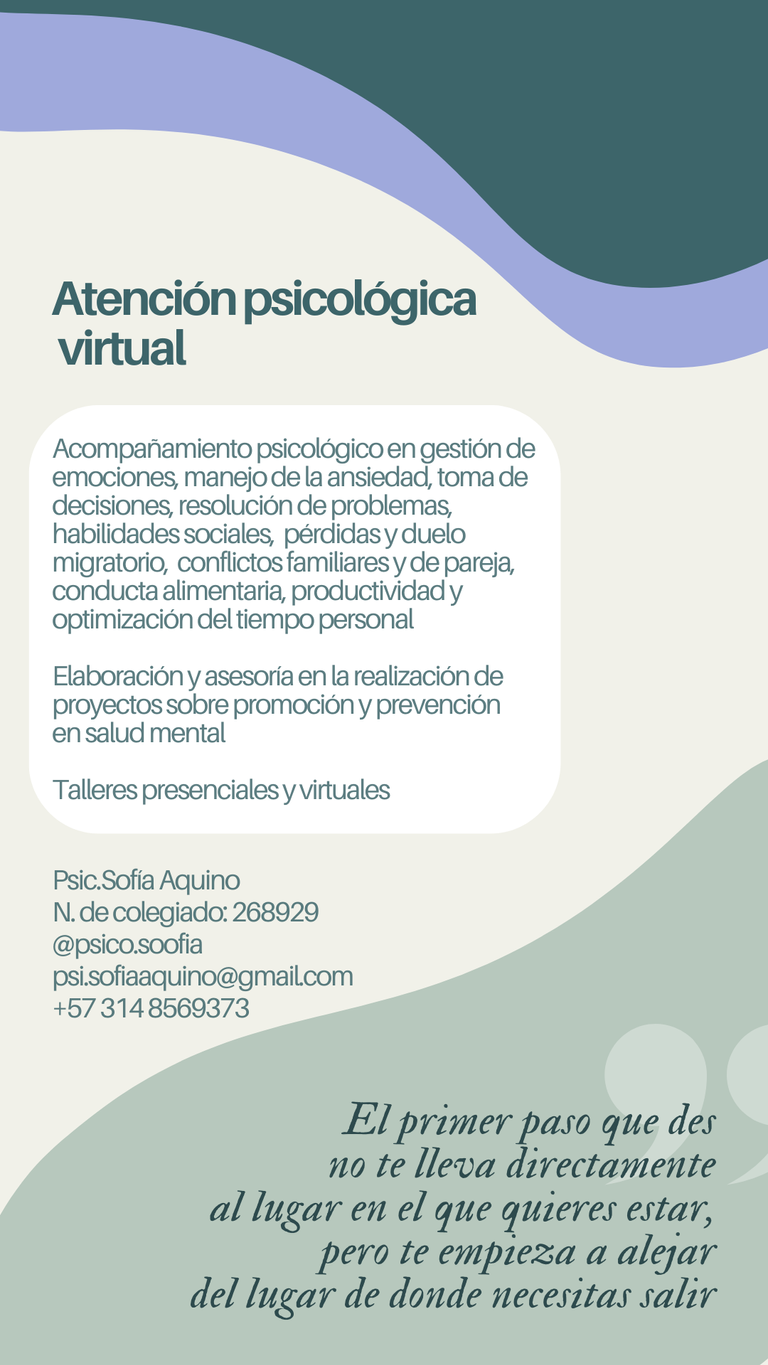Por qué algunas personas no aceptan que tienen un problema/ no les interesa cambiar

En mi blog he dejado plasmado a lo largo de los años mi interés por la prevención y la promoción de la salud, tanto física como mental. A esto dedico la mayoría de mis artículos. Y aunque trabajo diariamente con los conflictos emocionales y con cuadros y síntomas psicopatológicos, no concibo a las personas desde una óptica patologizadora.
Pienso que, en general, tenemos los recursos o los podemos desarrollar, para llevar vidas tranquilas y satisfactorias. Sin embargo, también es cierto que, algunas personas no están abiertas a la posibilidad de trabajarse internamente y mejorar, la mayoría de las veces porque no quieren o no pueden cuestionar sus creencias, pensamientos y/o comportamientos. Estos están fuertemente arraigados y los llevan a actuar prácticamente en piloto automático, sin una posibilidad para reflexionar, modificar o cambiar estos patrones.
Ya lo he comentado antes, el pensamiento flexible es un indicador de buena salud mental, el pensamiento rígido no.
Para comprender esta situación que describo es necesario hacer alusión a dos conceptos importantes para la psicología:
[1] Decimos que una característica de personalidad, o un síntoma es egosintónico cuando a la persona no le genera malestar significativo su forma de enfrentarse a una determinada situación o problema. Si decimos que es egodistónico, entonces es que lo vive con malestar o incomodidad. [cita textual]
La mayoría de las personas que asisten voluntariamente a consulta psicológica, presentan síntomas egodistónicos, es decir, pensamientos, emociones o acciones que son discordantes con su autoimagen o yo. Por ejemplo, tener pensamientos intrusivos, verse dominado por los impulsos, dificultades en las relaciones interpersonales, incapacidad de cumplir con un objetivo, adicciones, y así un largo etcétera.
Como bien sabemos, la asistencia a consulta es un indicador de interés por la salud mental, más NO es un indicador de presencia o ausencia de enfermedad. En ese sentido, muchas personas viven sus vidas sin haber asistido alguna vez a consulta psicológica, a pesar de que, algunas de ellas, presentan rasgos de un diagnóstico o de entrada cumplen con todos los criterios. A pesar de esto, no se dan cuenta pues el síntoma es egosintónico, es decir, no le genera malestar y está en sintonía con sus necesidades y expectativas actuales. Quizás pueda llamar la atención de las personas al rededor, pero no de la persona en sí misma.
La dificultad que se presenta con los síntomas egosintónicos es que entran en conflicto con el cambio, pues la persona no los ve como un problema. Por ejemplo, en el Trastorno Narcisista de la Personalidad, verdaderamente creer que se es superior a los demás y que merece un trato especial o en un cuadro paranoide, verdaderamente creer que alguien le quiere hacer daño o que es víctima de un ataque (aunque no existan pruebas de esto).
La capacidad de autoevaluación, la empatía para ver la vida desde diferentes perspectivas, incluso la posibilidad de cuestionarnos es saludable, en su justa medida. Socialmente, además, funcionamos como mecanismos de regulación, celebramos lo que consideramos que está bien, reprobamos lo que consideramos que está mal (lo más bonito de esto es que no es estático, y que los estándares cambian con el paso del tiempo y el esfuerzo de la gente que habla, por ejemplo, de las injusticias). Pero quizás, con esta publicación podamos entender situaciones que confunden y que se pueden resumir en las siguientes preguntas:
1.- ¿Esta persona realmente no se da cuenta de sus formas distorsionadas de pensar?
2.- ¿Por qué siempre me hace sentir que el problema soy yo?
3.- ¿Por qué a esta persona no le interesa cambiar/mejorar?
Referencias bibliográficas:
[1] Psicólogo de Cabecera. Qué es egosintónico y egodistónico


In my blog I have expressed over the years my interest in prevention and health promotion, both physical and mental. To this I dedicate most of my articles. And although I work daily with emotional conflicts and psychopathological symptoms and pictures, I do not conceive people from a pathologizing point of view.
I think that, in general, we have the resources, or we can develop them, to lead calm and satisfying lives. However, it is also true that some people are not open to the possibility of working on themselves internally and improving, most of the time because they are unwilling or unable to question their beliefs, thoughts and/or behaviors. These are strongly rooted and lead them to act practically on autopilot, without a possibility to reflect, modify or change these patterns.
As I have said before, flexible thinking is an indicator of good mental health, rigid thinking is not.
To understand this situation I am describing, it is necessary to allude to two important concepts for psychology:
[1] We say that a personality trait, or a symptom is egosyntonic when the person does not feel significant discomfort in the way he or she deals with a given situation or problem. If we say that it is egodystonic, then it is that the person experiences it with discomfort or discomfort [textual citation]
Most people who voluntarily attend psychological consultation, present egodystonic symptoms, i.e., thoughts, emotions or actions that are discordant with their self-image or self. For example, having intrusive thoughts, being dominated by impulses, difficulties in interpersonal relationships, inability to meet a goal, addictions, and so on and so forth.
As we well know, consultation attendance is an indicator of interest in mental health, but it is NOT an indicator of the presence or absence of disease. In this sense, many people live their lives without ever having attended a psychological consultation, despite the fact that some of them present features of a diagnosis or meet all the criteria at the outset. In spite of this, they do not realize it because the symptom is egosyntonic, i.e., it does not generate discomfort and is in tune with their current needs and expectations. It may attract the attention of the people around them, but not of the person him/herself.
The difficulty with egosyntonic symptoms is that they conflict with change, as the person does not see them as a problem. For example, in Narcissistic Personality Disorder, truly believing that one is superior to others and deserves special treatment or in a paranoid condition, truly believing that someone wants to harm him or her or that he or she is the victim of an attack (even though there is no evidence of this).
The capacity for self-evaluation, the empathy to see life from different perspectives, even the possibility of questioning ourselves is healthy, in its proper measure. Socially, moreover, we function as regulatory mechanisms, we celebrate what we consider to be right, we reprove what we consider to be wrong (the beauty of this is that it is not static, and that standards change with the passage of time and the efforts of people who speak out, for example, about injustices). But perhaps, with this publication we can understand confusing situations that can be summarized in the following questions:
1.- Does this person really not realize his distorted ways of thinking?
2.- Why does he/she always make me feel that I am the problem?
3.- Why is this person not interested in changing/improving?
Bibliographical references:
[1] Psicólogo de Cabecera. What is egosyntonic and egodystonic?

Posted Using InLeo Alpha

Interesante tema. El primer paso hacia la curación es reconocer la enfermedad
Muy cierto es que nuestras creencias influyen sobremanera nuestro comportamiento, ya sea funcional o no. Tenemos una representación del mundo que incluye en su nuestras percepciones sobre el y su funcionamiento así como las causas atribuidas a estos fenómenos. Indiscutiblemente nuestras creencias poseen un alto componente afectivo y ello incide muchas veces en la dificultad para modificarlas cuando no resultan funcionales.
Gracias por tu aporte y coincido contigo.
Un saludo!